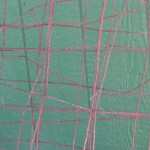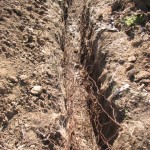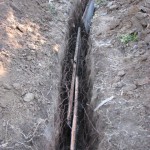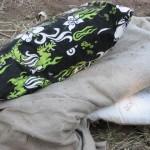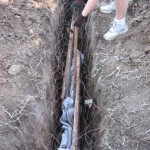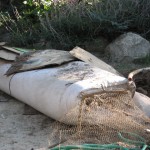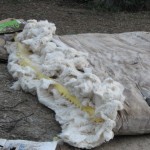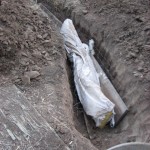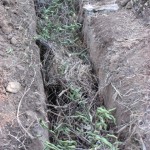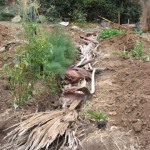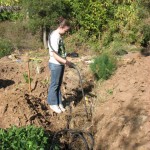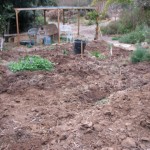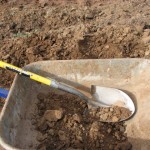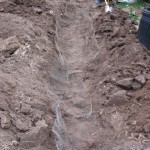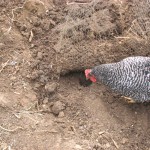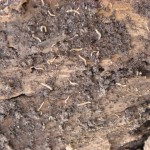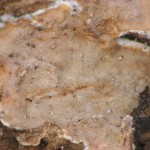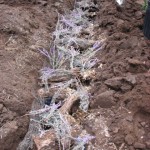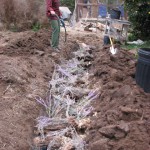Pets
- Animals, Bees, Birding, Building and Landscaping, Chickens, Compost, Fungus and Mushrooms, Gardening adventures, Hugelkultur, Microbes and Fungi, Natives, Natural cleaners, Other Insects, Permaculture and Edible Forest Gardening Adventures, Pets, Ponds, Predators, Quail, Rain Catching, Reptiles and Amphibians, Water Saving, Worms
Saving the Bees

The ponds at Finch Frolic Garden are cleaned by fish and plants, with no chemicals, algaecide, artificial aeration or filtration. Well-balanced water allows wildlife to thrive. I should have more accurately called this post, Saving All the Insects, or even Saving the Wildlife, because the answer to saving one is the answer to saving them all. We’ve been inundated for years – my whole lifetime, in fact, – with pleas to save our environment, stop whale slaughter, stop polluting, etc. I remember winning a poster contest in fifth grade on the subject of curtailing littering. Since Rachel Carson’s books woke people up to the hazards of DDT and how chemicals have many deadly side effects there has been a grassroots effort to stop the pollution. Since Al Gore’s An Inconvenient Truth came out the push for environmentally friendly lights, cars, LEED-certified buildings and many more positive anti-climate-change actions have grown furiously. Too bad no one listened to him decades before. A drop in the economy and the radical change in weather patterns have people exploring organics, making their own clothes and foods, changing their shopping habits and thinking about what they are bringing into their homes. However, this week the World Wildlife Fund released the staggering results of a study that states that between the years 1970 and 2010, 52% of the world’s animal populations are gone. Over half. Gone. On our watch. In my lifetime. I am stunned with shame. So what about the next 40 years? Over 97% of California wetlands are already gone. There are only 3% left in Los Angeles. The Colorado River hasn’t met the ocean for decades, except briefly last year due to major earthworks. We are pumping all that water overland, open to the sun for evaporation, to treatment plants that fill it with chlorine and other chemicals, then sell it to us to spray over lawns and flush down the toilet or let run down the drain while the water heats up. It is madness. All the wildlife that depended upon the Colorado River along that stretch are gone. All the insects, the frogs, lizards, birds, mammals, etc. that need a clean drink of water no longer have access to it. The only water they can drink is usually chlorinated domestic water in ponds and bird baths. Too often this water is treated with algaecide, which claims it doesn’t hurt frogs but it does kill what the frogs feed upon. We are killing our animals with poisoned domestic water.
![dry_colorado_new[1]](http://www.vegetariat.com/wp-content/uploads/2014/10/dry_colorado_new1-613x321.jpg)
One of the largest reasons we have extinctions in North America is mismanagement of rainwater in drylands (other than polluting the waters. Poaching, over-fishing, destruction of habitat and climate change are the main reasons). We have cleared and flattened the ground, and channel rainwater off into the ocean. Look around at your streets and houses. Are they harvesting water or channeling it? Any property that is slanted is channeling water away. Any property that is level – like the bottom of swales – is harvesting water. So many properties are inundated with annual rains because there is no water harvesting above them. When you harvest water, it runs into rain catchment basins and swales instead of roaring down the hillside taking all the topsoil with it. Water becomes passive and percolates down deeply into the soil. That deep saturation draws tree roots down into the ground. The roots break up hardpan, make oxygen and nutrient channels into the dirt and produce exudates (sugars, carbohydrates and starches) through their roots to attract and feed the billions of microbes that turn your dirt into rain-holding soil. That underground plume of rainwater then slowly passes through your soil, re-enervating subterranean waterways, refilling your wells and bringing long-dry streambeds back to life. We must harvest rainwater to save our animals and plants, and consequently ourselves. We must reestablish sources of clean, unpolluted chemical-free water for animals to eat and from which to drink.
Healthy pond water is off-color due to tannins, and is filled with tiny creatures. Some such as daphnia are visible, but just like soil microbes, many aquatic creatures are microscopic. Fish and frogs feast from this level of the food chain, and these creatures make the water balanced. They eat mosquito eggs. They clean up algae. They are as vitally important as soil microbes. Oh, and 83% of the frogs are gone.
I spoke with Quentin Alexander from HiveSavers today; he performs humane bee rescue around the San Diego area and has been trying to re-queen Africanized hives with calmer European queens which will breed nicer behavior back into the bees rather than having to kill the entire hive. He has had no luck in the past two years with European queens, even those bred in California. With very little wetlands left, and those often sprayed with DEET by Vector Control, or polluted with chemical fertilizers and oils washed out of front yards, streets and driveways, these insects must resort to drinking from swimming pools and bird baths. Again, these contain highly chlorinated water. Animals are being forced to drink poison, or not drink at all.
We MUST stop using chemicals on our properties, and we MUST harvest rainwater. We MUST stop spraying well water into the air but irrigate with it in dripper form under mulch so that it is cycled back into the ground rather than evaporated. One inch of rain on one acre in one hour is 27,154 gallons of water! It is so easy to harvest rainwater – dig level-bottomed swales! Dig small ones with a trowel. Fire up the tractor and turn road ways into swales, or cross-cut vertical paths with swales that have dedicated overflows. Dig rain catchment basins to catch a flow of water. Catch water as high up on your property as you can. If you have level soil, fantastic! You have it so easy!
Make gentle swales, rain gardens, rain catchment areas and sunken gardens to catch and percolate the water. Bury old wood perpendicular to water flow – its called hugelkultur.
Please watch this six-minute video by Geoff Lawton of the Permaculture Design Institute of Australia. You need to type in your name and email, but they don’t sell your information nor do they bug you with lots of emails. Here is the link. The title is Finding An Oasis in the American Desert, and it is about the Roosevelt swales dug during the dust bowl in the desert. If nothing that I say, nor anyone else says can convince you, then please watch this and see the effectiveness of rain harvesting. We MUST do this, and now before the rains come is the time. Catch all the water that falls on your property in the soil, and try to catch the water that runs into it. If there are flood waters channeled through your property, see if you can talk to the people who own land above you about harvesting water up there. It will reduce the flooding, save topsoil and benefit everyone’s property. Work towards keeping rainwater in your soil, reducing your domestic water, and making what streambeds are left come back to life. Keep our old trees from dying by watering deeply through rain catchment. If you have a pond or swimming pool and treat it with harsh chemicals and algaecides, seek out a natural pond professional. In the San Diego – Los Angeles region there is Bob Lloyd of PuraVida Aquatics, or Jacob Hatch of Hatch Aquatics. Jacob builds natural ponds and maintains large natural waterways. Bob maintains chemical-free backyard and display ponds that are full of wildlife. He can convert your pool into a clean swimming pond where the water is filtered by plants and thus is lovely year-round, provides abundant habitat and doesn’t need chemical treatments. No chlorine to burn your skin and eyes. How great is that? He can also create a constructed wetland that cleans your greywater with plants.
There are so many simple and inexpensive ways to harvest rainwater rather than allow it to flow into the salty ocean without penetrating the soil. Please, please, please do them, and if you already have THANK YOU and gently encourage your neighbors to do the same. We must stop the habitat destruction and start to rebuild what is gone.
- Animals, Bees, Birding, Building and Landscaping, Chickens, Cob, Compost, Composting toilet, Fungus and Mushrooms, Gardening adventures, Giving, Health, Heirloom Plants, Hiking, Houses, Hugelkultur, Humor, Living structures, Natives, Natural cleaners, Other Insects, Permaculture and Edible Forest Gardening Adventures, Pets, Photos, Predators, Quail, Rain Catching, Recycling and Repurposing, Reptiles and Amphibians, Seeds, Soil, Vegetables, Water Saving, Worms
Special Tours for Aug. and Sept., 2014
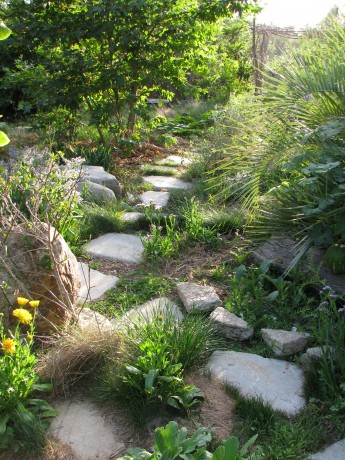
Come take a tour of a food forest! Normally tours of Finch Frolic Garden are held by appointment for groups of 5 – 15 people, Thursdays – Mondays. Cost is $10 per person and the tour lasts about two hours. By popular demand, for those who don’t have a group of five or more, we will be hosting Open Tour days for the first 15 people to sign up in August and September. They will be Sunday, August 10 and 24, Sept. 7 and 21, and Thursdays August 7 and 28, and Sept. 11 and 25. Tours begin promptly at 10 am. The tours last about two hours and are classes on basic permaculture while we tour the food forest. I ask $10 per person. Please reserve and receive directions through dianeckennedy@prodigy.net. Children under 10 are free; please, no pets. Photos but no video are allowed. Thank you for coming to visit! Diane and Miranda
-
Striving for Healthier Hens

Nora and Branwyn enjoying the sun on our windowseat. The last six months have been very difficult chicken-wise. We lost Chickpea to a coyote, who snatched her a few yards from us, we lost Miss Amelia and Madge from unknown ailments, and we’ve nursed chickens back to health as well. Mulan had a prolapsed uterus, which we cleaned, stuffed back in coated with honey from our own bees and bandaged. She recovered and is laying happily, thank goodness. Viola and a couple of others had impacted crop, which means that they swallowed something like long pieces of grass which have blocked up the exit from their crop to their stomach. There have been many mornings I’ve spent making a chicken throw up, without breaking her neck or suffocating her. We’ve been frazzled with the health of our hens, all purchased through feed stores. Our past chicken experiences had no egg binding, no septic peritonitis, no crossbill (which should have been bred out of the hens) and no infected eyes.
I’ve purchased mostly organic feed for them, and given them greens in their large Fowl Fortress or brought them into the fenced yard for grazing. Organic feed is amazingly expensive. Since we don’t eat the hens and we use their eggs as one of our main protein sources, they need to be in good productive health. Chickens can live ten years or more, and lay that long, too. Ours seem to top off at three.
I tried fermenting their food. Fermented food is all the rage and I read many articles about the health benefits of fermenting chicken food. In a 5-gallon bucket I’d mix water and their lay crumbles along with some cracked corn and wait a couple of days until it smelled yeasty. Then I’d give them some and replenish the bucket. It took awhile for the hens to come to like the food, but it didn’t seem to do anything for their health. In our warm San Diego weather it was tricky to not have the fermented food spoil. Eventually I gave that up.
One of the hen’s purposes in the garden is to create compost. They excel at pooing. When the opportunity arose to be able to pick up discarded fruit and vegetables from the Fallbrook Food Pantry four times a week, I jumped at it. Much of the produce is still edible for the hens; when mixed with pooey straw and dirt the chickens could grub out, well, grubs and fly larvae and eat more naturally. Although we’re still picking it up, we are devoting hours a week lugging stinky veggies around. It is hard and heavy work, and the fly population has exploded. However we have seen more flycatchers hanging around the yard recently and the phoebe is truly fat. I shovel and rake the produce mixed with carbon sources (paper goods from the house mostly) and then the hens kick it all over. It is good exercise for them, they eat far less lay crumble, and they are producing some very good quality compost for the veggie garden. Their health has been better.
One of the reasons that the hens came down with just about every known illness was because they were purchased from hatcheries. Hatchery birds live in hell from the second they are born. Since few people want roosters, the male chicks are swept into trash bags and thrown away, live. The female chicks are inoculated and packaged up for shipment through the mail. There are always extra chicks packed in because the heat of the ones on the outside keep the ones on the inside warm enough to possibly survive the stressful, hungry, thirsty and brutal trip. Therefore the ones on the outside of the bundle are sacrificial. I didn’t want to support this animal cruelty any longer.
I decided to find a local breeder who cared for her hens. I found someone who seemed reputable; her mother owns a feed store and the woman breeds horses, dogs and hens. On conversation with her I learned that she had imported chickens from good stock and bred them at her place. The hens weren’t inoculated, but that wouldn’t matter to us since we have a small isolated flock. With glee I ordered four pullets, from several weeks old to a couple of months. They were different breeds and were to lay different egg colors. We sectioned out the back of the Fowl Fortress and happily put the girls in. Not long after we found out they were crawling with lice. None of our other girls had lice, thank goodness. Upon contacting the woman she said that she’d put Frontline on the hens per advice from her vet. We smeared Vaseline around the eggs that encrusted their necks and powdered diatomaceous earth on their bodies. We’ve repeated the treatment, but we haven’t won the war yet. I noticed when we picked the girls up that the blue maran, Nora, had a watery eye. That eye became infected, and we learned that it was probably a small eyeball, and now she’s blind in that eye. Just a few days ago her other eye was bothering her so we are treating it. She is underweight, and Miranda noticed that her beak was overgrown so it was hard for her to peck food. Miranda trimmed it, having had lots of experience with our poor late crossbill, Belle. So Nora lives for the time being in the house as we hope that she doesn’t go completely blind, and as we try to feed her up so that if the time comes when we can reintroduce her, the flock won’t attack her.
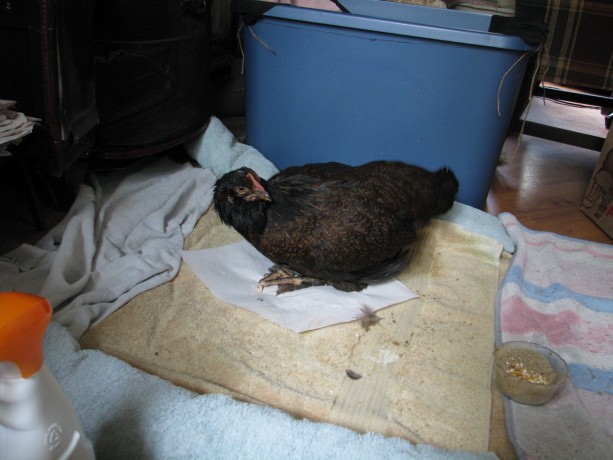
Branwyn balancing herself on her weak forelegs. Then there is Branwyn. She’s a feisty olive-egger. A few weeks ago Miranda noticed that Branwyn’s legs were bowing out as she walked. By the time she brought the bird up to the house she was paralyzed in both legs. Our immediate fear was Merek’s disease, which is highly communicable and would have meant death for all our birds, sterilization of the coop and no hens for six months or more. Within days Branwyn showed signs of moving her left leg. Miranda configured a Rubbermaid container as a bouncy chair, tying a t-shirt across it and cutting leg holes through it so Branwyn could rest with legs down and feet touching the bottom. Later, Miranda cut the legs from an old pair of tights and stuck Branwyn through to bounce her across the floor, giving her physical therapy. Sounds nutso, I know, but its working. Branwyn’s left leg is much stronger and she’s beginning to force her right leg to work. She can’t stand, but she can now get her feet under her. We still don’t know what was wrong with her; some kind of neurological disorder or possibly vitamin deficiency. We were giving her Vitamin E and B complex with selenium heavily for a week and saw her initial improvement. Vitamin deficiency can be inherited; common chicken feed should have enough in it, especially when combined with vitamins in their water.
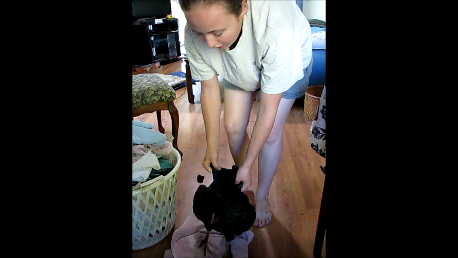
Miranda walking Branwyn in her sling made of old tights (to the tune of Surrey With The Fringe On Top). Lark, who was huge with sterile peritonitis, was drained by the vet and is several pounds lighter and much happier. She’s with the rest of the flock. Since we have no idea what caused the condition (she’s barren), it might happen again but for now she’s back kicking fruit around with the rest.
I still don’t want to participate in the hatchery butchery and torture. Anything mass-produced, be it animals, food, plants or products, are rooted in cruelty: sweat shops in other countries, underpaid workers, poor root stock, diseased, malnourished and maltreated animals, unhealthy chemical-laden food. I’m holding off on purchasing any new hens, even though I wanted a lavender Americauna. I still think that buying local, while more expensive, is better. For whatever reasons this batch have all been ill. In fact, the only hens we’re treating right now are all four of the new girls!
Chickens have wonderful personalities and make great pets, and they are pets; having a few hens for eggs and meat sounds easy but just like any living thing they require work. Especially OUR hens, who must know we won’t cull them and have decided that we are an early retirement home with personal nursing care. I wish I could look forward to such a deal!
- Animals, Bees, Birding, Chickens, Cob, Compost, Composting toilet, Fungus and Mushrooms, Gardening adventures, Health, Heirloom Plants, Hiking, Humor, Living structures, Natives, Natural cleaners, Other Insects, Permaculture and Edible Forest Gardening Adventures, Pets, Photos, Ponds, Predators, Quail, Rain Catching, Reptiles and Amphibians, Seeds, Soil, Water Saving, Worms
Finch Frolic Facebook!
Thanks to my daughter Miranda, our permaculture food forest habitat Finch Frolic Garden has a Facebook page. Miranda steadily feeds information onto the site, mostly about the creatures she’s discovering that have recently been attracted to our property. Lizards, chickens, web spinners and much more. If you are a Facebook aficionado, consider giving us a visit and ‘liking’ our page. Thanks!
- Compost, Gardening adventures, Hugelkultur, Other Insects, Permaculture and Edible Forest Gardening Adventures, Pets, Rain Catching, Soil, Worms
The Sunken Bed Project, Part Two
Old wire can be buried! Remember the trenches? We lined the trenches with old rusty wire, to rot, add iron to the soil, and discourage rodents. Mostly just to get rid of it. Inside the wire we lay old wood; in this case, the half-rotten sides of the old raised beds, nails and all. Fabric can be buried, too! Pet bedding no longer fit for man nor beast. Except for microbes of course. Around the wood we packed old fabric, most of which had been dog or cat bedding after long use in the house. There was also this futon! It had been a bed for years, and then it was the bed for the dogs for years. And for some mice. It took a little cutting and pulling to separate the cotton batting and the foam. Although the foam isn’t made from a natural material, it will eventually rot, but meanwhile will function like a ginourmous buried sponge for rainwater! The futon slices layed in the trench. Yipee! The stinky old futon is gone! Lots of branches, twigs, and woody materials were added, as was some year-old humanure, urea, and fallen limes. Nasty prickly lime tree branches, too. Serves them right for scratching me! After layering the trench materials with soil I used palm fronds for the top organic layer. Every step was watered in. Our 700-gallon water tank, formerly an organic fertilizer tank which Jacob managed to have donated, catches some of the roof rainwater. It has more than enough to water in this project, and then if it ever rains again the tank will be empty and ready for fresh water. The trenches filled in. Futons, scrap wood, woody bits, old stinky fabrics, manure… its all buried and ready to turn the clay into a microbial wonderland. We hauled chunks of extra clay up the hill and staged it by the upper pond, which needs to be resealed. Good leg exercise. The long hugelkultur strawberry bed was above ground, so it had to be reworked. We dug out the wood, wrestled out the wire, dug down about a food then lay the wire back down. There were gopher tunnels under the wire where they had come up and smashed their little noses against the wire. The wood that had been buried for a year was full of life! There were many very cool fungi. Tiny centipede-type decomposers eating away at the wood, all of which had been underground. More great fungus. On top of the wire went some more old textiles, then most of the old wood. Bunches of herbs that had been gathered for wreathes and not used were tucked in around the wood. Worms love thin woody stuff. Pigeon guano, thanks to our neighbor who delivers, was sprinkled over it all. Everything was well watered with rainwater, and then covered up. Next time: design, replanting asparagus, and perhaps even the final product! -
Good-bye, Sweet Belle: The Death of a Crossbill Hen

Belle in her bath. Last Tuesday when I opened the chicken tractor to let the girls come bounding and clumsily flutter out for their breakfast, Belle our genetic crossbill Americauna didn’t emerge with her usual energy. I make a custard of blended chicken food, whole eggs, greens and fruit, cooked and cooled, to feed her. The custard contained all the goodies the other hens had, but was easier for her to scoop with her twisted beak. I’d fill her dish before I come down to ‘do the hens’, and she was fed first. Her dish was placed into the top of the quail hut with the door propped open so only Belle coud get in and out; the other hens loved to share her food otherwise.
Although Belle ate vigorously, she never gained full body weight. Her beak prevented her from eating well enough. Out of every five scoop attempts at the custard I’d say that she’d get one mouthful. Yet she was always perky, always running around interested in everything, and even tried dominance tactics over some of the other girls. They’d let her since she wasn’t a threat to any of their food.
Because Belle’s eating habits were very messy her neck and head feathers were straggly, and combined with her twisted beak gave her a comical, slightly crazed look. Because she was handled so much when she patiently allowed us to trim her beak and nails, and give her a bath, she was very friendly. She’d jump on our backs and shoulders any time we’d bend over in the coop. She’d enjoy being carried around. She was very spoiled. We’d read posts where owners of crossbills, who didn’t cull them but kept them as pets, had them live up to ten years and lay eggs. It was all dependant upon to what degree their bills crossed, and Belle’s became severe.
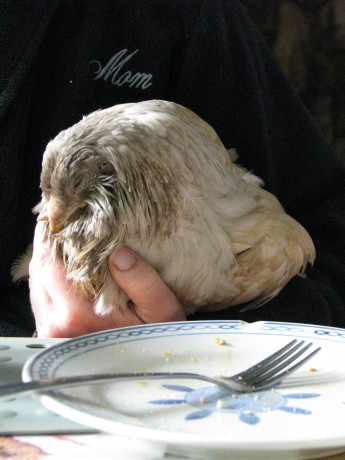
About a month ago we noticed mites on her, something that is common on hens, and gave her a good bath and treatment with food grade diotomaceous earth. The FGDE works immediately and is very effective and safe. Otherwise she was bright, fun and perky, burrowing under the other girls on the roost overnight to cuddle.
Tuesday Belle was slower to come around, and didn’t want to eat. A hungry hen not wanting to eat? Bad news. We immediately took her into the house. It was a cold day, so we made her comfortable next to a space heater. On inspection we discovered that she had mites all over her. We also checked the other hens right away and they were all okay, so apparently Belle’s diminishing health encouraged them to reproduce, and as she couldn’t groom herself she was stuck. We coated her with FGDE, not wanting to bathe her while she was feeling poorly since it was a cold day, and dropper fed her food. She showed some energy and wanted to run around, and took the food hungrily.
It was time to trim the Christmas tree, and my daughter put Belle under her sweater to keep her warm and comforted as we worked; Belle loved being cuddled and held, so she put up no resistance, but we could see that she was ill.
We brought in the cage that we used for Viola the ex-house chicken, and for all of our patients, and tucked Belle in for the night next to the space heater.
In the morning Belle was sitting very still. I knew that she was nearly gone. Just after waking my daughter, Belle died as she held her. She is buried outside our bay window where we watch birds, close to the house.
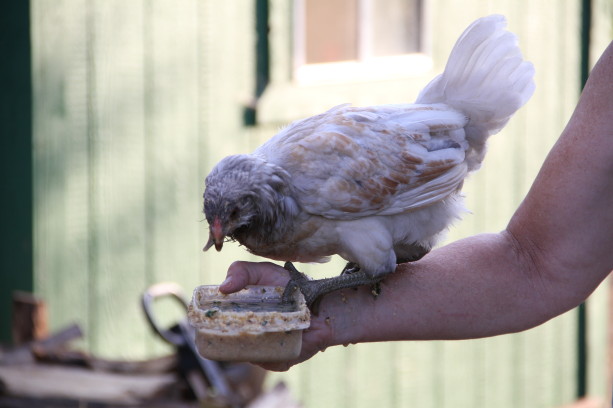
Belle usually can’t wait until she’s served. Birds are so tricky. They can seem perfectly fine, but when they show illness it is usually too late and the end comes quickly. There is little you can do for them besides keep them comfortable. Neither of us expected Belle to pass away; she showed no previous symptoms and was her usual plucky, fun self. Something internal gave way from slow malnutrition caused by that darned crossed bill and her inability to eat enough. On reflection I don’t think that Belle had a bad life. She ate enough to not be hungry all the time, and her custard gave her ease of eating. She was much loved and spoiled. Her end was quick, which was merciful and not granted to many of us. But Belle will always be remembered.

Ah haz a friend! -
Coyotes
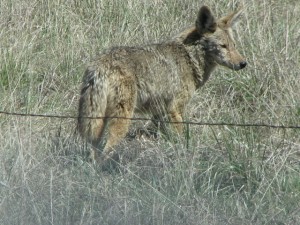
A coyote from some years back. Fall and winter are the times of year when many outdoor pets disappear. I’ve blogged on this before, too. ‘Teenaged’ coyotes, hungry (just like human teens!), bolder and less cautious will come closer to homes and people to grab food. If there is pet food outside the house, coyotes will take it if they can. If you have small pets outside, even chained, they can be killed by coyotes.
This doesn’t make coyotes evil. They are predators, a very necessary part of the food chain. Look up ‘trophic cascade’. That is how preditors in a wild environment cause prey animals to keep moving in natural patterns. Unthreatened, not only can prey animals reproduce to extremes, but also they will linger over feeding areas and eat plants down to the ground rather than trim them and move on.
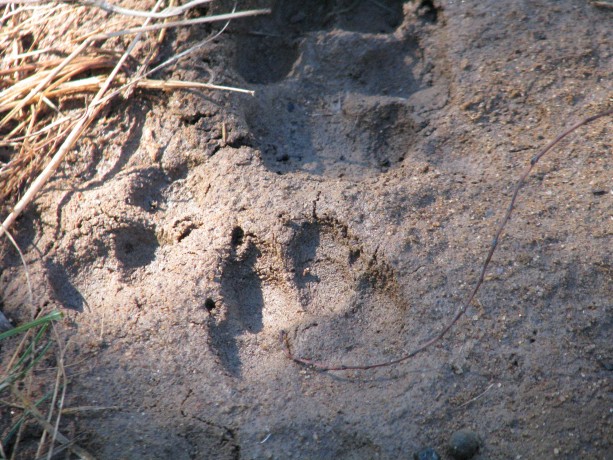
Coyote pawprints by the pond where they stopped for a drink. Dog pawprints have nails; cat (mountain lion!) pawprints don’t because their nails retract. Coyotes are intelligent, loyal, family-oriented, playful animals. They also make very scary sounds when howling and yipping in packs. Coyotes are no threat to humans unless the coyotes are sick, or if a child comes close when a coyote is eating outdoor pet food and is frightened.
Now that our last dog, Sophie, has passed away, coyotes are jumping the five-foot chainlink fence nightly and hunting in our yard. They have been unable to breach the Fowl Fortress (the hens are also locked into their coop within the FF for double protection). Unfortunately on Halloween I let the hens out of the coop about 45 minutes before dark. They had just gone under the Mock Pavilion, and I went into the FF to give Belle some of her special mash when there was a wild clucking. A coyote had come close and grabbed Chickpea our Americauna, and they were gone. My daughter saw it running away, and I dashed after, losing my slippers on the way, and hunted all over the neighbor’s yard but there was no sign of her.
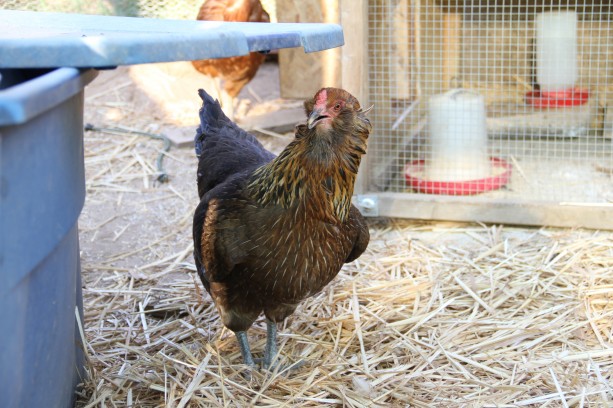
It was tramatizing, and I kick myself because I should have known better, even though I was just yards away and the hens had been released only minutes before. It was a lucky chance for the coyote, who must have already been in the yard but hidden by plants. At least it was a quick death for our darling Chickpea. It hurts us both that she is gone. No more ‘outies’ for the girls, even with a hensitter.
The coyotes leave scat in our yard and we can tell what they’ve been eating.
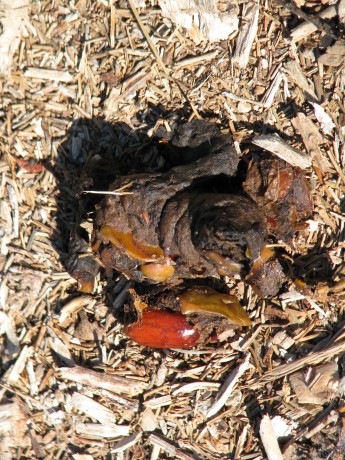
Sorry. Yes, it is coyote scat. Notice the seeds. Tiny seeds show that they were eating figs off of some volunteer fig trees down in the barranca. Larger seeds and skin in the scat shows that they are eating the red Eugenia berries in our yard. There is never much fur in the scat, so these omnivores have to scavenge to stay alive.
On the funny side, one day a few weeks ago I saw some fuzzy green thing in the yard.
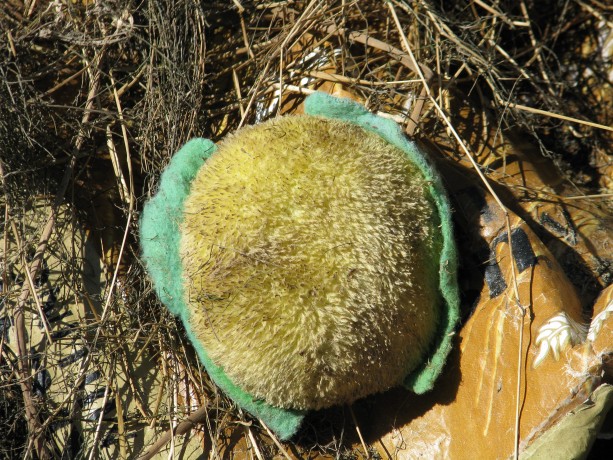
A coyote-delivered squeaky toy. It has since had its squeaker removed, and been slowly shredded by visiting coyotes. It turned out to be what looked like the center of a plush sunflower dog toy. It squeaked. It wasn’t ours. Some young coyote found it in another yard, carried it over the fence and played with it down by our pond. Over the next week it was moved around each night. One morning I found it next to a veggie bed I’d recently planted.
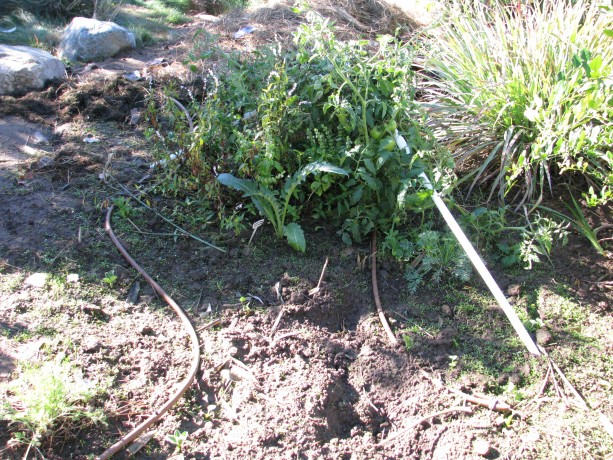
Where is my snake?? Then I realized that the rubber snake I put down in the bed to discourage birds was gone! My daughter and I looked everywhere for the snake, even for pieces of it, but it was gone! Some neighbor is going to have a real bad moment one of these days when walking through their property and they come across my rubber snake.
- Animals, Bees, Chickens, Health, Natural cleaners, Other Insects, Permaculture and Edible Forest Gardening Adventures, Pets, Quail, Worms
DE for Birds, and More About Chickens
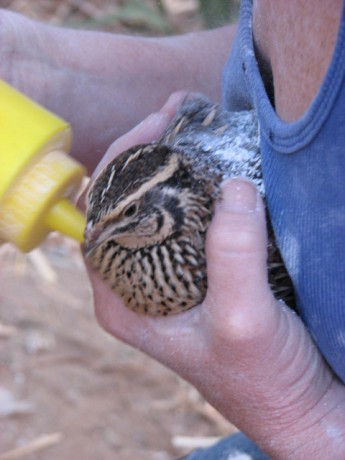
A little mustard with your quail? Cleopatra being treated. I’ve written about using Food Grade Diatomaceous Earth around plants to keep down ants and other sectioned insects. It is also used around the feet of my bee hives; as long as it isn’t where bees and other beneficials go it won’t hurt them because it has to be on the bug to work. I’ve also used FGDE around my cat’s bedding to kill hatching flea eggs, and have rubbed it into their fur. It is scentless, edible (will help kill interior parasites when eaten), tasteless, and the food grade is so fine that it won’t hurt your lungs if you breathe it in, although if you have lung conditions you should wear a mask. More about FGDE in a minute.
Some of our laying hens have difficulty laying eggs recently. Chickpea we found panting on the ground in a wet spot, with ants on her. She had a soft-shelled egg break inside of her.

Madge in the house cage, recooperating. Madge, our partially blind RIR passed a soft shelled egg, then was ill for a day when she passed a broken shell. Warm Epsom salts baths and time spent in the house cage with a heating pad helped both of them. Because of the threat of infection I used some of the Cephalexin left over from our dog (divided into small doses) on both of them and they recovered. My daughter finally deduced that in the mornings when the pullets and hens were released the big girls ran over to eat the chick mash. It probably tastes better than the lay pellets, and more importantly in their little brains it kept the pullets from eating it. Even with the supplemental oyster shell the big girls were probably not getting the calcium and other nutrition their bodies needed to make good eggs. It was time to switch the small girls to lay mash anyway, so I did and yesterday we had all four of our laying hens lay eggs… first time in a long time!
While we were bathing Madge in the sink for her illness, my daughter noticed mites on her. Now a few mites are usual on everyone and everything. When you can see several on the skin when you blow on the feathers, then you have a problem. She wasn’t having a problem, but at that time we still didn’t know what was wrong with her. After she was better we instituted FGDE Day in the Fowl Fortress.
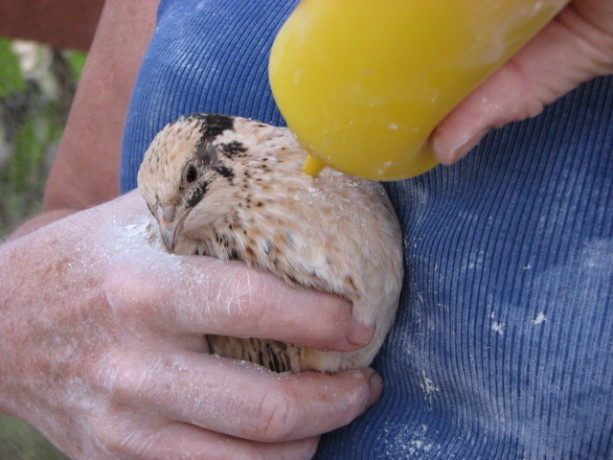
Miss Lemon, one of three coturnix hens, is treated with FGDE. You can buy pricey powder dispensers, which usually clog. I bought a set of mustard and ketchup dispensers for less than two dollars and they work just fine. We caught all the hens and our three quail and puffed FGDE into their feathers and, of course, all over ourselves.
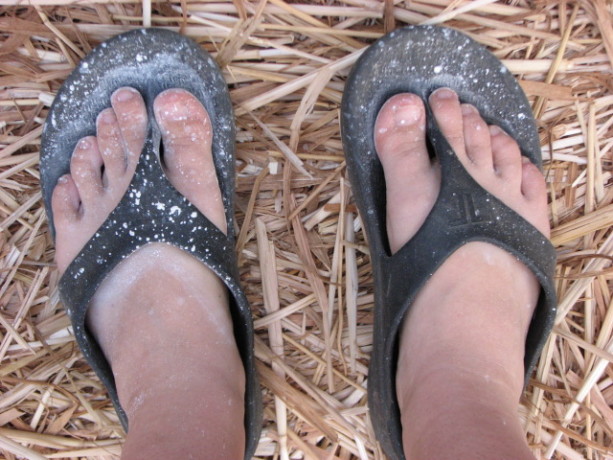
We treat ourselves, too. I puffed it into the nesting boxes, and into the ‘attic’ of the pullet house where they roost, and into the straw in the coops. Since we don’t have a problem we don’t need to treat often, just every few months or so. Any that they eat helps with any internal parasites as well. We also had some wood ash left over from making pizzas in Harry Mud the cob oven and sprinkled them where the birds take dust baths. That fine ash helps to keep their feathers clean and keep away mites too.
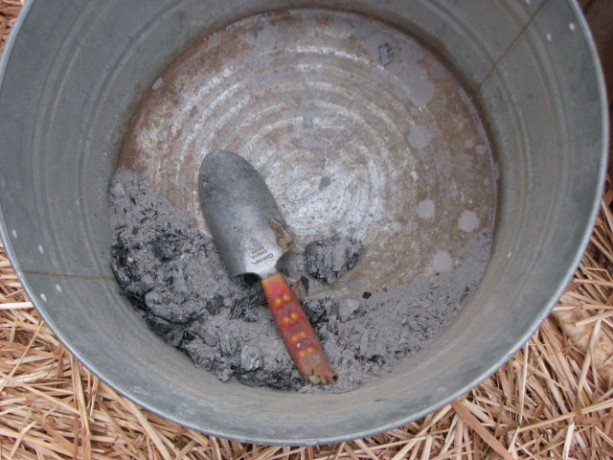
Wood ashes are good for dust baths. Very little went a long way, so even after treating all the hens and the Fowl Fortress, the cat bedding repeatedly, several cats, the feet of the bee hives, a variety of plants, and the feet of the food tables I’d set up for a garden party to protect from ants, along my window sills and around the privy where ants were getting in, I’m still working on the first bag that I bought on Amazon.com.
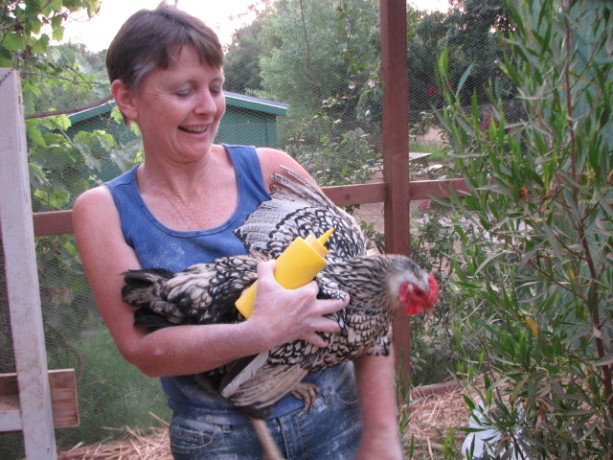
Amelia objecting to her dusting. When you compare with buying expensive different poisons for all of these problems, the health hazards and impact on non-target species including ourselves, and the negative impact on the Earth, one bag of FGDE is such a deal that you really can’t not try it.
-
Release of the Pullets, and No More House Chicken
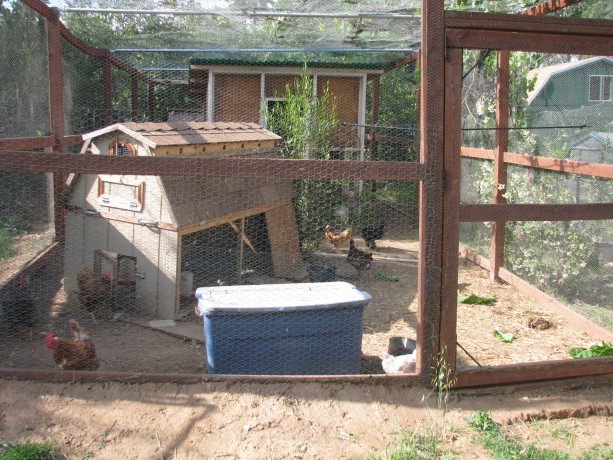
The Fowl Fortress and its many inhabitants. It was time. The little chicks were half-grown and beginning to eat scratch and pelleted chicken food along with their chick starter. They had finally figured out how to go upstairs at nighttime although it took several tries where I had to pick them out of their chick pile and shove them through the upstairs egg window. A couple of times when I’d let the big girls out into the garden, I had let the little girls out into the Fowl Fortress. They had run around stretching their wings and barreling into one another. So it was time for them to join the big girls as one large flock.
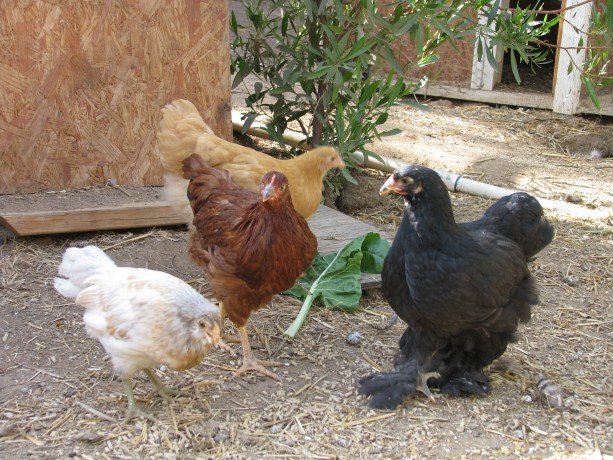
Four of the seven little girls. L-R: Belle, Charlotte, Esther (or Myrtle. They look and act the same), and Mulan (please don’t be a rooster!). And then there was Viola, the house chicken. She’d been a house chicken for over half a year, enjoying her special front yard paradise, coming when called, stealing some dog and cat food, caging herself at night, and crooning away whenever I sneezed or made noise while she slept. I really loved to have my house chicken. However she was alone a lot. She protested her aloneness by shrieking horribly for long periods of time. She could shriek with both exhaled and inhaled breath so that the noise didn’t stop. Even when at the end of my rope I yelled at her to shut up, she shrieked. She was becoming a spoiled and lonesome chicken. Her leg, the reason for her separation from the flock, was doing well again. I thought that if there was ever a good time to reintroduce her it would be at the same time that I let loose the little girls. There would be less hostility against Viola when the hens reinforced their pecking order. It was a very hard decision to make, but I thought it was for the best. I left the cage up in the house, though, just in case.
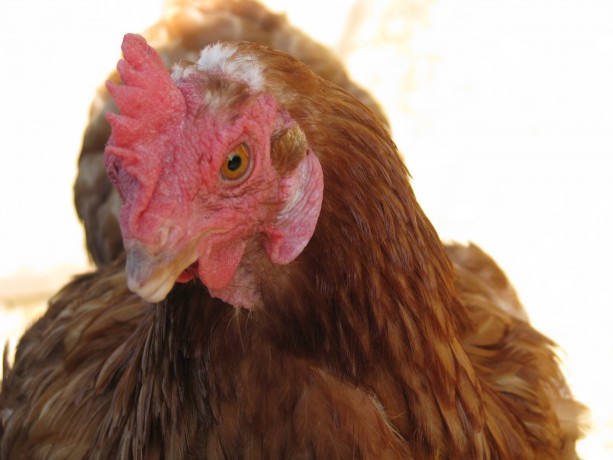
Madge: not just a rescue anymore! Uber hen! Last week I gave Viola a surprise and brought her down to the coop when I let the hens out of their chicken tractor. Viola wasn’t happy about it. Immediately Madge, the one-eyed Rhode Island Red who had been caged with Viola at the feed store when both had been seriously pecked, who had been her only friend for a year with my other girls, decided to punish Viola for her absence and make sure she knew she was at the bottom of the pecking order. She didn’t just give Viola – who is smaller – a peck, she tried to remove feathers. She jumped her and chased her. I had to get between the two of them. Pushing the vicious Blind Pirate Madge away just made her more intense, so I tried picking her up and giving her attention.
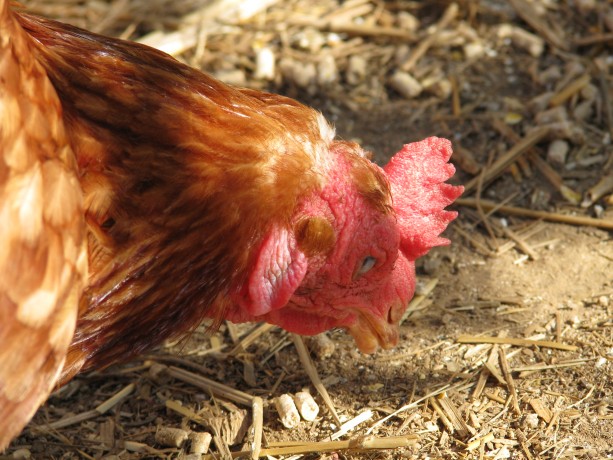
Paritally blind Madge… who’d have thought that she’d give the others the fish-eye? That worked better. Still, Viola had to hide. With Viola between my legs for protection I released the little girls.
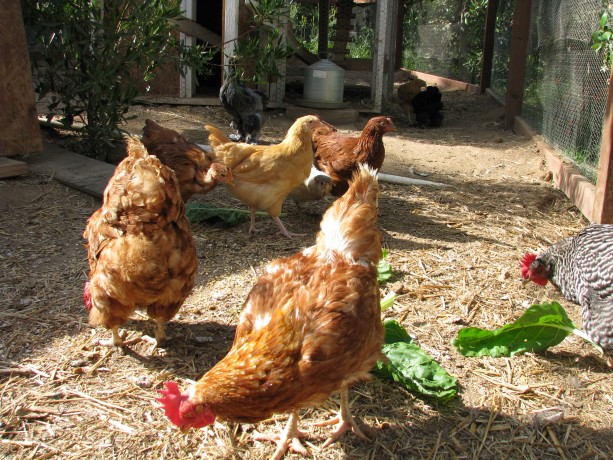
Viola staying close. L-R: Madge’s butt, Malaika, Esther (or Myrtle), behind is Bodacea, crouching is Belle, Charlotte, in the back is Myrtle (or Esther), Mulan, and on the right is Lark. Not pictured: Chickpea and Miss Amelia, the flock leader. The big hens… pretty much ignored them. The little girls were so happy to be free. I kept their food inside their coop and propped the door so that only the smaller birds could get in there, but the big girls managed to shoulder themselves in anyway.
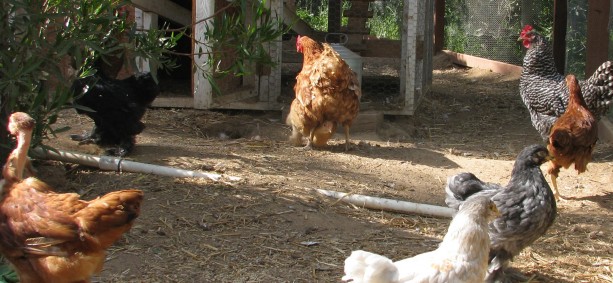
Madge shows her ranking to Myrtle as others look on in alarm. Lark, the Barred Rock who has been barren since she survived egg binding and who has been enjoying her work-free status has developed some kind of uncomfortable swelling. At first I thought she was just fat, but her tummy swelled like a balloon over several weeks. She lost her feathers on her red rump.
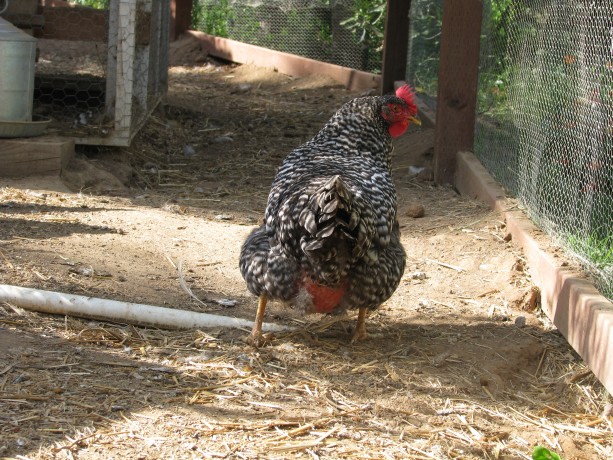
Lark’s uncomfortable ailment. It became awkward for her to walk so I gave her a couple of Epsom salt baths in the kitchen sink, and she became a house guest for a couple of days. She wasn’t as pleasant as Viola, but enjoyed the new experience. I returned her to the coop, and just today the swelling seems much less, thank goodness. The whole illness has not, however, affected her appetite.
Belle, the crossbill Americauna, had such difficulty eating that she is smaller than the rest and seemed to always be famished.
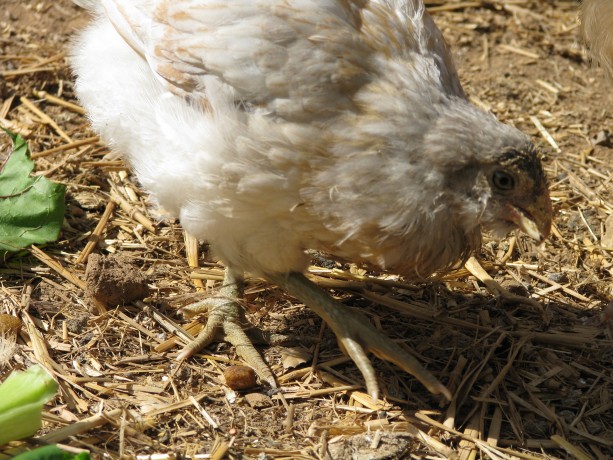
Belle, the Americauna who has the cross-bill trait. Small but sassy, and usually covered with mash. I finally found a small, deep tupperware container that I could wedge between a piece of wood and the side of her coop where it wouldn’t tip over easily, and filled it with chick starter and water mash. Belle was eating heartily for the first time since her bill began to cross and for once she had time to spend goofing around with a full tummy. And a messy face and breast. Since I’d tried trimming her beak, and since I make the magic mash for her now, she has become not only an energetic chicken but a devotee of me. While the other ingrates run away as if I were an axe murderer rather than the vegetarian that I am, Belle flies onto me at any chance. With Viola between my ankles and Belle running up my back I feel very much a part of the flock.

Ah haz a friend! -
Chick’s New Home
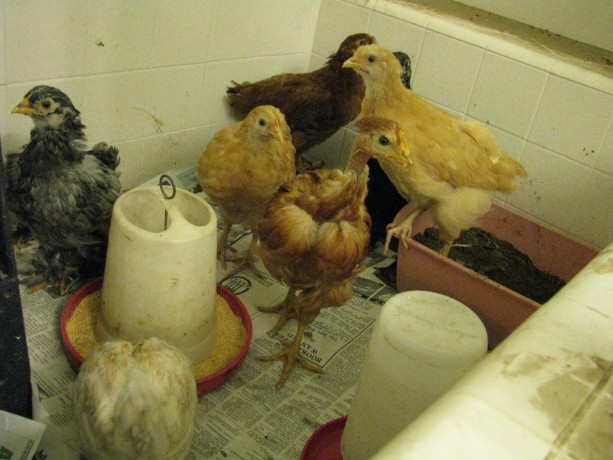
“We’re going where?” I know, I know, another chicken post. This should be the last one for awhile and I’ll get back to plants and chocolate desserts. Today I moved the 6-week-old chicks from out of the bathtub to their new quarters. They are living in a coop within the Fowl Fortress.
The coop had been occupied by Saki, a coturnix quail that ended up being male and thus having to be separate from the other two who were female. Males are extremely aggressive and usually have a harem of at least six. I don’t eat fertile eggs, nor want to hatch more quail so he was separate. He also managed to injure his wing a month ago, then a week ago escape the Fowl Fortress and unfortunately get himself killed. I miss his warbling, frantic call for his ladies. The coop had also apparently been occupied by mice and rats, as I found out when I cleaned out the top nesting portion. The rodents would only use it during the night and disappear like fairies by day, leaving lots of un-fairy-like poo all over the place. I cleaned it out on top while the big girls helped kick out all the old nesting material from the inside.

Getting a little help from my friends (Madge) cleaning out the coop. The girls (and I certainly hope they are!) were so much larger than the last time I carried them outside to the porch that I could only fit three into the banker’s box and had to put another one upside down on top to keep them there for transportation down the hill. I thought I’d put them into the top portion so they’d get familiar with it, then make their way down the ramp to the bottom.
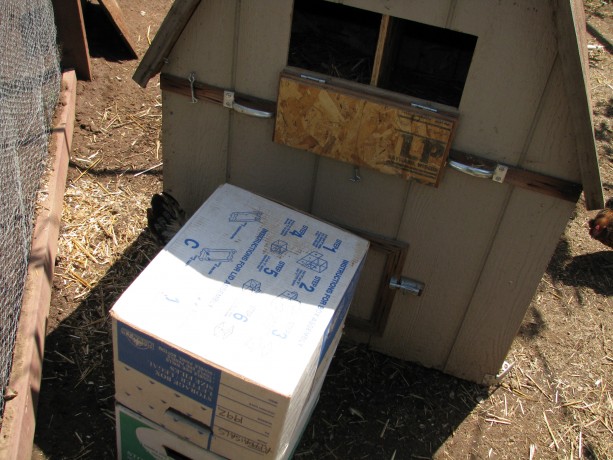
Two banker’s boxes with three huge chicks waiting to be shoved through that egg-collecting door. For over an hour all I heard was rustling, tiny little rushed footsteps and an occasional mini-squawk. I tried to entice them down, but for a long time there were no takers. Finally two came down, and one went up again, then another came down and went up again. About an hour later I looked in and they were all down enjoying the afternoon sun and wondering where the plumbing was (they lived in a bathtub… get it??? 🙂 ).
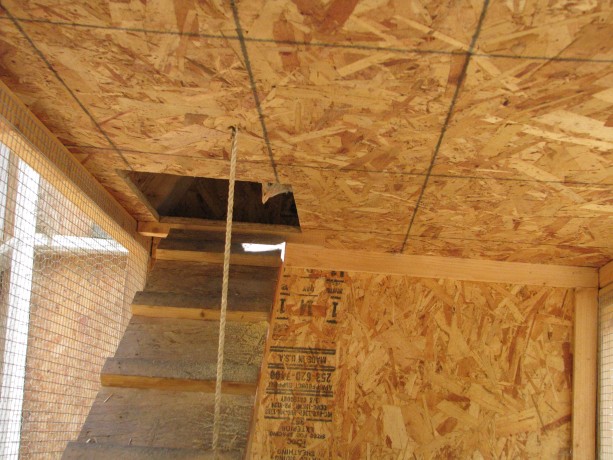
Little peepers peeping. That’s Esther, and she didn’t come down till last. However after sundown when all the big girls went into their coop, the little girls crowded around in the corner looking bewildered. I had to crawl in there, catch them and shove them back up the escape hole into the roosting area.
Kids. Sigh.
Now I need get the offer of cleaning services and clean the bathroom and the entire mostly empty bedroom which is coated with a thin film of chick dust.
But not tonight.

